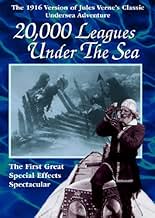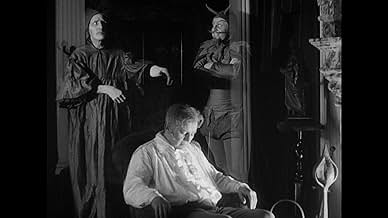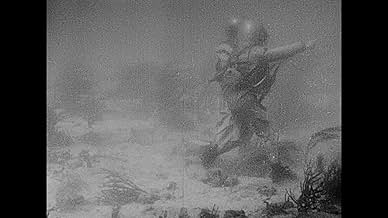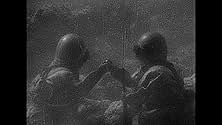VALUTAZIONE IMDb
6,1/10
2151
LA TUA VALUTAZIONE
Aggiungi una trama nella tua linguaA French professor and his daughter accompany Captain Nemo on an adventure aboard a submarine.A French professor and his daughter accompany Captain Nemo on an adventure aboard a submarine.A French professor and his daughter accompany Captain Nemo on an adventure aboard a submarine.
- Premi
- 1 vittoria in totale
William Welsh
- Charles Denver
- (as William Welch)
Wallis Clark
- Pencroft
- (as Wallace Clark)
Joseph W. Girard
- Maj. Cameron
- (non citato nei titoli originali)
Ole Jansen
- Undetermined Secondary Role
- (non citato nei titoli originali)
Noble Johnson
- Undetermined Secondary Role
- (non citato nei titoli originali)
Leviticus Jones
- Neb
- (non citato nei titoli originali)
Martin Murphy
- Herbert Brown
- (non citato nei titoli originali)
Jack Tornek
- Undetermined Secondary Role
- (non citato nei titoli originali)
Recensioni in evidenza
This film combines plot elements of Verne's original 20,000 Leagues Under the Sea and Mysterious Island, then adds its own subplot involving the origin of Captain Nemo that ties everything together. I was very impressed by the writing. This was the first major film with underwater photography. The set design was impressive. I found the diving suits to be particularly interesting--essentially early versions of scuba gear. The new score fit very well into the story. All in all, a wonderful and landmark achievement in filmmaking.
7j-cf
OK, this movie isn't at all faithful to Verne's novels (both 20000 leagues & Mysterious island), but who cares. It was too difficult for that time to stay close to the characters and to the relationship between Arronax and Nemo, which is based on the talking, showing different philosophical points of vue. So there we stick to a melodrama full of suspense and action. The pacing is quite fast, for a 1916 movie. A lot of characters and settings are involved, the cinematography is most of the time quite good and the actors are... so so. But it's the editing that attracts attention here, in a griffithian narration full of "parrallel editing" as we say in french. Some sequences are composed of four or five parallel actions, and sometimes flashbacks are used to add another dimension to the melodrama. The same fact is related three times by three different characters, each flashback being longer than its predecessor until the final revelation (that we can guess early in the film, but, as for most of gender movies, the pleasure for the viewer comes from the combination between waited events and surprising elements) narrated by Nemo himself. I don't know anything as for the origin of the version I own on DVD, so this editing question is to stay questioned. But as it is there (I saw the 1h45 version, a Jokanan copy), it's a really imaginative movie, a sort of serial with a complexer narration. It is sometimes a little boring anyway, especially when it deals with Arronax and co (Ned Land is useless, and the real hero of the movie arrives later on) and with submarine sequences (no so many, in fact, but a little childish sometimes). The documentary aspect is anyway interesting (the shark scene, an early Cousteau sequence) and from an historical point of view those sequences are very important.
A good movie, not as brilliant as the Fleischer version, but entertaining and representative of the evolution of American cinema at that time.
Just for the record: it's quite possible that the Nadia anime series by Anno Hideaki have been highly inspired by this movie (I won't say anything else, avoiding spoilers. Watch for yourself).
A good movie, not as brilliant as the Fleischer version, but entertaining and representative of the evolution of American cinema at that time.
Just for the record: it's quite possible that the Nadia anime series by Anno Hideaki have been highly inspired by this movie (I won't say anything else, avoiding spoilers. Watch for yourself).
I found this film extraordinary, if for no other reason than the fact, that that they used underwater photography showing divers in deep sea helmets using what looked to be rifles with spears attached (early spear guns, I imagine) actually shooting at a large group of sharks swimming around them. I also didn't see any air lines attached to any of these divers, however, if you looked closely, you could see some air bubbles come out of the helmets of the divers every so often. They must have been using some type of compressed air with a regulator, however when I queried Google, I was informed that SCUBA wasn't invented until 1939 for the US Navy and the air regulator hadn't been invented until 1943 by Jacques Cousteau. There was a device that contained compressed air in a belt attached to a diver's helmet that was invented in 1825 but that would only allow a diver to stay under 7 minutes. Were they really able to get all of the shots with the divers within that time frame. Very curious. Does anyone have the technical details for how this film was accomplished? I give this film a 9 for technology and a 5 for story line and acting for a 7 overall.
This early adaptation of "20,000 Leagues Under the Sea" is interesting, and generally entertaining, though it lacks the depth of the original story. Its strengths are the underwater effects, the settings, and the camera work, which at times are remarkable for the era. On the other hand, it makes little attempt to convey the most important themes of Verne's story, settling instead for straightforward adventure and melodrama, which are much easier to film.
One can only guess how exciting it might have been in 1916 to see some of these images and special effects. Only occasionally does it falter a bit and lose the illusion of reality for a short time; otherwise it is quite convincing. Just seeing the underwater photography alone must have been pretty impressive at the time, and they also managed to get some interesting sea creatures on film. The photography itself is pretty good throughout the movie, and some of the props and settings are nicely done.
The story draws rather freely both from "20,000 Leagues ... " and also from another Verne story, "Mysterious Island". It is a mostly entertaining yarn, full of action and with some unexpected developments. But only a small portion of Verne's scientific vision comes across, and none of the depth of the characters and of their interactions has been preserved. Captain Nemo is one of literature's more complex and thought-provoking characters, but here he becomes more of a stock melodrama figure. Professor Arronax and Ned Land are mostly spectators, rather than providing worthy foils for the mad genius Nemo.
It's by no means a bad movie, and if you are a silent film fan and/or are interested in film history, there should be enough here to make it worth watching. But otherwise, the 1950's Disney version does a much better job of filming the profound vision and philosophical conflict found in Verne's original novel.
One can only guess how exciting it might have been in 1916 to see some of these images and special effects. Only occasionally does it falter a bit and lose the illusion of reality for a short time; otherwise it is quite convincing. Just seeing the underwater photography alone must have been pretty impressive at the time, and they also managed to get some interesting sea creatures on film. The photography itself is pretty good throughout the movie, and some of the props and settings are nicely done.
The story draws rather freely both from "20,000 Leagues ... " and also from another Verne story, "Mysterious Island". It is a mostly entertaining yarn, full of action and with some unexpected developments. But only a small portion of Verne's scientific vision comes across, and none of the depth of the characters and of their interactions has been preserved. Captain Nemo is one of literature's more complex and thought-provoking characters, but here he becomes more of a stock melodrama figure. Professor Arronax and Ned Land are mostly spectators, rather than providing worthy foils for the mad genius Nemo.
It's by no means a bad movie, and if you are a silent film fan and/or are interested in film history, there should be enough here to make it worth watching. But otherwise, the 1950's Disney version does a much better job of filming the profound vision and philosophical conflict found in Verne's original novel.
White-bearded mystery man Allan Holubar (as Captain Nemo) trolls the seas, looking for revenge against William Welch (as Charles Denver). We begin when Mr. Holubar's invention, an underwater ship called a submarine, is mistaken for a sea monster. Commanding the "Nautilus", Holubar wants to avenge the abduction of his wife and find his "child of nature" daughter Jane Gail (as Princess Daaker). He defeats, then compassionately rescues a crew of attackers, and goes near "Mysterious Island". Coincidently, enemy Welch and daughter Gail end up there, the latter falling in love with Matt Moore (as Lieutenant Bond)...
Reportedly, the first submarine photoplay ever filmed, "Twenty Thousand Leagues Under the Sea" begins with a tribute to the Williamson brothers, "who alone have solved the secret of under-the-ocean photography." The brothers Ernest and George Williamson appear in an on screen introduction, tipping their hats (and looking like they could have had careers as actors). The film is mainly notable for their work in pioneering underwater photography; otherwise, this adaptation of Jules Verne's popular novel (with additions from his "The Mysterious Island") is sluggish sailing. It also corrupts the source material.
***** Twenty Thousand Leagues Under the Sea (12/24/16) Stuart Paton ~ Allen Holubar, Jane Gail, Matt Moore, William Welch
Reportedly, the first submarine photoplay ever filmed, "Twenty Thousand Leagues Under the Sea" begins with a tribute to the Williamson brothers, "who alone have solved the secret of under-the-ocean photography." The brothers Ernest and George Williamson appear in an on screen introduction, tipping their hats (and looking like they could have had careers as actors). The film is mainly notable for their work in pioneering underwater photography; otherwise, this adaptation of Jules Verne's popular novel (with additions from his "The Mysterious Island") is sluggish sailing. It also corrupts the source material.
***** Twenty Thousand Leagues Under the Sea (12/24/16) Stuart Paton ~ Allen Holubar, Jane Gail, Matt Moore, William Welch
Lo sapevi?
- QuizUnderwater cameras were not used. The Williamson brothers had developed a system of watertight tubes and mirrors, like an upside-down periscope, and were dependent on the clarity of water and sunshine to provide the necessary light.
- BlooperIn one scene on the island the balloon survivors are at a table and a black servant appears. He never shows up again and is not rescued at the end of the film with the rest of the survivors.
- Citazioni
Capt. Nemo: I am Captain Nemo and this is my submarine, 'Nautilus'... It has pleased me to save your lives... You are my prisoners.
- Curiosità sui creditiThe opening titles announce "The First Submarine Photoplay Ever Filmed".
- Versioni alternativeKino International released a video with a music soundtrack by Alexander Rannie and Brian Benison (music © 1991). Running time is 101 minutes.
- ConnessioniFeatured in Hollywood Aliens & Monsters (1997)
I più visti
Accedi per valutare e creare un elenco di titoli salvati per ottenere consigli personalizzati
- How long is 20,000 Leagues Under the Sea?Powered by Alexa
- Can I watch this film online?
Dettagli
- Data di uscita
- Paese di origine
- Lingua
- Celebre anche come
- Twenty Thousand Leagues Under the Sea
- Luoghi delle riprese
- Azienda produttrice
- Vedi altri crediti dell’azienda su IMDbPro
Botteghino
- Budget
- 200.000 USD (previsto)
- Tempo di esecuzione1 ora 25 minuti
- Mix di suoni
- Proporzioni
- 1.33 : 1
Contribuisci a questa pagina
Suggerisci una modifica o aggiungi i contenuti mancanti

Divario superiore
By what name was 20,000 Leagues Under the Sea (1916) officially released in India in English?
Rispondi


























